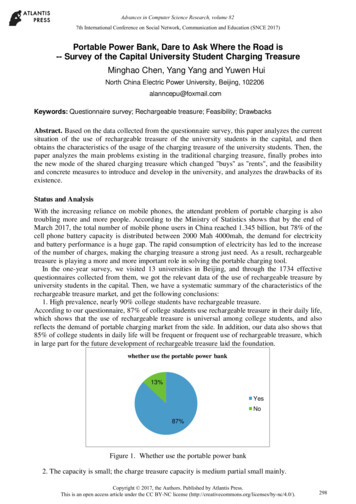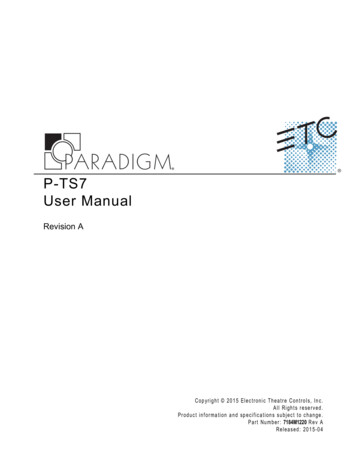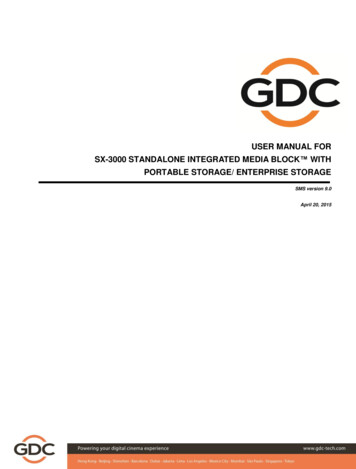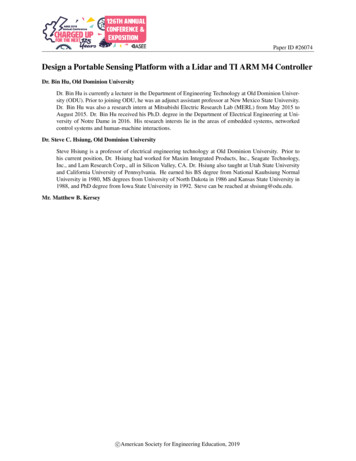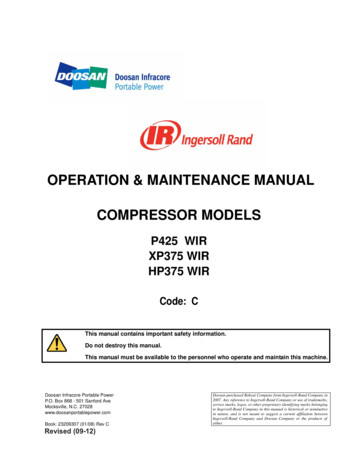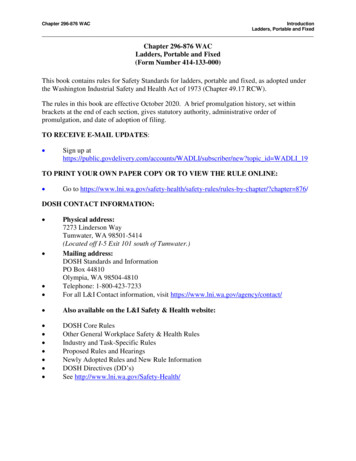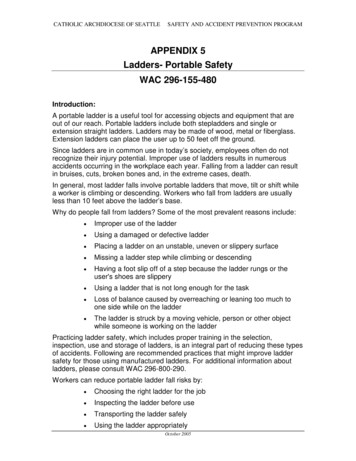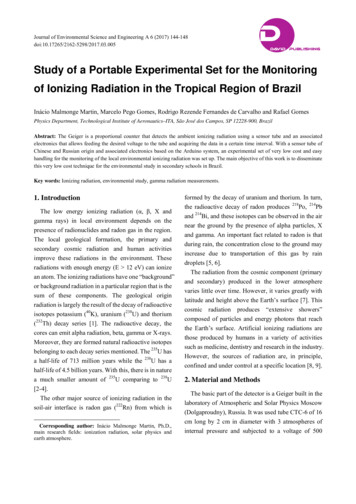
Transcription
Journal of Environmental Science and Engineering A 6 (2017) LISHINGStudy of a Portable Experimental Set for the Monitoringof Ionizing Radiation in the Tropical Region of BrazilInácio Malmonge Martin, Marcelo Pego Gomes, Rodrigo Rezende Fernandes de Carvalho and Rafael GomesPhysics Department, Technological Institute of Aeronautics–ITA, São José dos Campos, SP 12228-900, BrazilAbstract: The Geiger is a proportional counter that detects the ambient ionizing radiation using a sensor tube and an associatedelectronics that allows feeding the desired voltage to the tube and acquiring the data in a certain time interval. With a sensor tube ofChinese and Russian origin and associated electronics based on the Arduino system, an experimental set of very low cost and easyhandling for the monitoring of the local environmental ionizing radiation was set up. The main objective of this work is to disseminatethis very low cost technique for the environmental study in secondary schools in Brazil.Key words: Ionizing radiation, environmental study, gamma radiation measurements.1. Introduction The low energy ionizing radiation (α, β, X andgamma rays) in local environment depends on thepresence of radionuclides and radon gas in the region.The local geological formation, the primary andsecondary cosmic radiation and human activitiesimprove these radiations in the environment. Theseradiations with enough energy (E 12 eV) can ionizean atom. The ionizing radiations have one “background”or background radiation in a particular region that is thesum of these components. The geological originradiation is largely the result of the decay of radioactiveisotopes potassium (40K), uranium (238U) and thorium(232Th) decay series [1]. The radioactive decay, thecores can emit alpha radiation, beta, gamma or X-rays.Moreover, they are formed natural radioactive isotopesbelonging to each decay series mentioned. The 235U hasa half-life of 713 million years while the 238U has ahalf-life of 4.5 billion years. With this, there is in naturea much smaller amount of 235U comparing to 238U[2-4].The other major source of ionizing radiation in thesoil-air interface is radon gas (222Rn) from which isCorresponding author: Inácio Malmonge Martin, Ph.D.,main research fields: ionization radiation, solar physics andearth atmosphere.formed by the decay of uranium and thorium. In turn,the radioactive decay of radon produces 218Po, 214Pband 214Bi, and these isotopes can be observed in the airnear the ground by the presence of alpha particles, Xand gamma. An important fact related to radon is thatduring rain, the concentration close to the ground mayincrease due to transportation of this gas by raindroplets [5, 6].The radiation from the cosmic component (primaryand secondary) produced in the lower atmospherevaries little over time. However, it varies greatly withlatitude and height above the Earth’s surface [7]. Thiscosmic radiation produces “extensive showers”composed of particles and energy photons that reachthe Earth’s surface. Artificial ionizing radiations arethose produced by humans in a variety of activitiessuch as medicine, dentistry and research in the industry.However, the sources of radiation are, in principle,confined and under control at a specific location [8, 9].2. Material and MethodsThe basic part of the detector is a Geiger built in thelaboratory of Atmospheric and Solar Physics Moscow(Dolgaproudny), Russia. It was used tube CTC-6 of 16cm long by 2 cm in diameter with 3 atmospheres ofinternal pressure and subjected to a voltage of 500
Study of a Portable Experimental Set for the Monitoring of Ionizing Radiation in theTropical Region of BrazilVDC (Voltage Direct Current). The same Chinese tubeJ305 from RadiationD-v1.1 (CAJOE Electronics Co.,Ltd.) in China of 8 cm long to 1.3 cm of diameter with 5atmospheres internal pressure and with 400-500 VDC(Fig. 1). The electronics associated with the sensortubes consist of a power supply from 5 VDC to 500VDC with enough voltage stability. This source isintended to power the Geiger tubes with exactly thesame 500 VDC voltage. Another important segment ofthe circuit is to transform the analog signals from theGeiger sensor into digital signals to acquire thesesignals as a function of time with minimum accuracy ofseconds. In this work, the minimum time of 1 minutewas chosen to carry out the time series related to themonitoring of the local ionizing radiation.In Fig. 2, a block diagram of the feed and acquisitioncircuit used in this experiment is described.2.1 System 1 and System 2In relation to system 1, a 5 V voltage is supplied viaa USB/Serial cable and the code upload for ArduinoFig. 1145board (Model UNO R3) by the computer. Arduinoboard provides a 5 V ddp (5 V and 0 V GND Pins) tothe radiation detection system. The detection systemfeeds the Russian tube with a voltage ranging from 0 to600 V (nominal values). The Russian tube, when itdetects radiations, gamma or beta, emits pulses for theradiation detection system which then sends them tothe arduino (digital pin 2) converting them into digitaldata. These are sent and stored on the PC. The sameprocess occurs with System 2, but unlike System 1, theChinese Geiger J3058 is one of the components thatmake up the radiation detection system.3. ResultsThe measurements were carried out in a closedroom with air conditioning in 20 oC in the Laboratoryof Electricity and Magnetism of the Department ofPhysics of ITA (Technological Institute of Aeronautics),in São José dos Campos, SP, Brazil. Detector andassociated electronics were previously calibrated inITA laboratory using radioactive sources Cs-137, Sr-90Tubes (Russian and Chinese) with Arduino electronics and data acquisition with PC.
146Study of a Portable Exxperimental SetS for the Moonitoring of Ioonizing Radiaation in theTropical Region of BrazilBFig. 2matic of the deetector tube annd an associated electronics.SchemFig. 3Meassurements of vaariation of envvironmental ionnizing with Ruussian Geiger.and Po-210 in terms of energy from emitted phootonsand particlees: 1.17 MeVV, 0.90 MeVV and 5.4 MeVMrespectively [9].Between the March 15 to April 6 of 2017, theuninterrupteed monitoringg of the locaal environmeentalionizing raddiation was caarried out simmultaneously withwRussian Geiiger and Chinna Geiger. Thhe variation off theambient ionnizing radiation measuredd over the wholewperiod is shownsin Fiig. 3. Between 5,000-6,500minutes from the start of monitorinng, the radiaationn show dayy/night variaation. This issinteensity does notduee to continuoous rains in this period as shown innFig. 5. Betweenn the time 77,000 to 31,0000 minutes,,therre were no raains in the reggion only twoo drizzles anddthe presence of low cumuluss clouds that alsoa interfereein the greater or lesser inttensity of ennvironmentallioniizing radiatioon. This conndition alwayys exhibits avariiation of daay/night thatt also interfferes in theegreaater or lesserr intensity oof environmental ionizinggradiiation.
Study of a Portable Exxperimental SetS for the Moonitoring of Ioonizing Radiaation in theTropical Region of BrazilBFig. 4Meassures carried out in the same period and place with Chinaa Geiger.Fig. 5Meassurements of raainfall variatioon in (mm/min) in the periodd 03/15 to 04/066 of 2017.It can be seensin Fig. 4 that the Chinna Geiger deteectorexhibits lowwer performannce than Russsian Geiger, thisbeing due too being smalller in sensitivve area and beingthe glass sennsor tube. Commparing the wallswof the tuubes,the one mannufactured byy Russians iss thinner thann theChinese, alllowing moree entrances of particles andphotons. However, as shoown in Fig. 4,, the Chinese tubealso shows dryd periods annd rainfall in the region.In Fig. 5, iti is shown monitoring,malsso at each minnute,the variationn of the rain intensity in (mm/min.)(att the1477me location off the Geiger ddetectors.samItt is observed that betweenn 5,000 and 6,5006minutessof measurementsms rainfall wass present at thhe monitoringgsitee. Consideringg all the period, a total off 44.7 mm offrainnfall was measured at thee site. It cann be affirmeddobserving the measurementsms made and described innFigs. 3-5 that thee variations oof the local ennvironmentallioniizing radiatioon is related too the presencce of the rainssandd the greater or less insollation of the place due tooclouuds.
148Study of a Portable Experimental Set for the Monitoring of Ionizing Radiation in theTropical Region of Brazil4. ConclusionThinking about the teaching and ionizing radiation(environmental) in the Brazilian tropical region andsecondary school education, two Geiger Sensors withSensitive Tubes manufactured in Russia and Chinawere developed. The associated electronics based onthe Arduino system, presents very low cost, easyoperation with data acquisition and can vary fromseconds to hours of interval of measurements. Analogsignals from digital-switched detectors are recordedand saved in easy-to-use graphical (txt) files bysecondary students. It was shown to be very sensitiveand proven good functionality during the period fromMarch 15 to April 6, 2017. It was observed during thisperiod the variation (night/day) produced in the placeby the exhalation of radon gas (Rn-222). This gasthrough decay produces gamma rays and alphaparticles responsible for the observed variation(day/night) and during rains. It lends itself to secondaryeducation and in the first two years of the Brazilianuniversities as suggested experiments of laboratory ofexact sciences and of the Earth, given the low cost andvery simple operation.AcknowledgmentThanks to CNPq (National Counsel of Technologicaland Scientific Development) and CAPES (Coordinationfor the Improvement of Higher Education Personnel)by the fellowships grants support to the group’sresearchers and the ITA Division of FundamentalSciences for supporting this research.References[1]Grieder, P. K. 2010. Extensive Air Showers (Vol. 1).Springer: Verlag.[2]Bui-Van, N. A., Martin, I. M., and Turtelli Júnior, A.1988. “Measurements of Natural Radioactivity atDifferent Atmospheric Depths.” Ciencia e Cultura.Suplemento 40 (7): 407.[3] Fujinami, N. 2009. “Study of Radon Progeny Distributionand Radiation Dose Rate in the Atmosphere.” JapaneseJournal of Health Physics 44 (1): 89-94.[4] Martin, I. M., Gusev, A. A., Santos, T. A., andSismanoglu, B. N. 2015. “Radon Gas and IncreasingIntensity of Gamma Radiation near Ground LevelInterface on 2011 in Sao Jose dos Campos, SP, Brazil.”International Journal of Research in Engineering &Technology 3: 31-8.[5] Martin, I. M., Alves, M. A., Gomes, M. P., Ferro, M. A.,Pinto, M. L., and Antônio, F. C. 2013. “Measurements ofX and Gamma Radiation at Ground Level and TheirCorrelation with Atmospheric Electric Discharges andRainfall in São José dos Campos, SP, Brazil.” In 13thInternational Congress of the Brazilian GeophysicalSociety & EXPOGEF, Rio de Janeiro, Brazil, 26-29August 2013: 272-4. Society of ExplorationGeophysicists and Brazilian Geophysical Society.[6] Jayanthi, U. B., Gusev, A. A., Neri, J. A. C. F., Villela, T.,Pinto Júnior, O., Pugacheva, G. I., et al. 2005. “GroundGamma Radiation Associated with Lightning and RainPrecipitation.” In International Cosmic Ray Conference 1:117. Pune, India.[7] Babich, L. P., Bochkov, E. I., Kutsyk, I. M., and Rassoul,H. K. 2014. “Analysis of Fundamental InteractionsCapable of Producing Neutrons in Thunderstorms.”Physical Review D 89 (9): 093010.[8] Boardman, B. J. 2015. “Aware Electronic Corp.” AccessdMay 1, 2017. http://www.aw-el.com/users.html.[9] Martin, I. M., Germano, J. S. E., and Takaki, T. M. 2013.“ITA-DATALOGGER: Continuous Monitoring ofPressure, Relative Humidity, Temperature, RainfallIntensity and Dose of Ionizing Radiation near the Surfaceof the Earth in São José dos Campos, SP, Brazil.”Presented at 65th Annual Meeting of Brazilian Sciencefor Progress Society (SBPC), Recife, Brazil.[10] Gusev, A. A., Martin, I. M., Alves, M. A., and de Abreu,A. J. 2015. “Simulation of the Radiation Fallout fromGamma-Ray Measurements.” Modeling Earth Systemsand Environment 1 (3): 18.
monitoring of the local ionizing radiation. In Fig. 2, a block diagram of the feed and acquisition circuit used in this experiment is described. 2.1 System 1 and System 2 In relation to system 1, a 5 V voltage is supplied via a USB/Serial cable and the code upload for Arduino board (Model UNO R3) by the computer. Arduino



